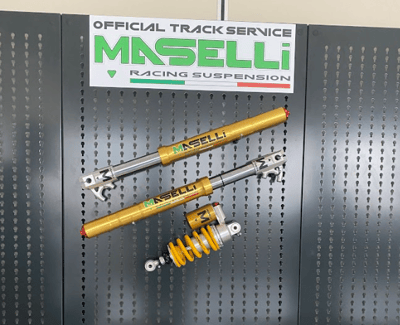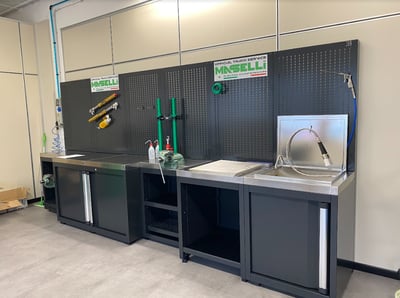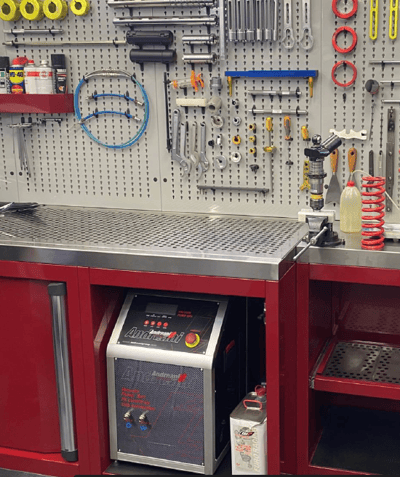 In the motorbike field, motorcycle suspension systems are talked about a lot, but a thorough look is required to get to know them thoroughly and handle them correctly.
In the motorbike field, motorcycle suspension systems are talked about a lot, but a thorough look is required to get to know them thoroughly and handle them correctly.
In this article we will analyse the role that the suspension plays in the vehicle, taking a detailed look at its composition and analysing which technical tools and equipment are required to ensure optimum management.
Find out more!
Motorbike suspension: why is it fundamental?
Motorbike suspension is an essential component because the performance of the vehicle depends on it.
When installing and overhauling these components, a very delicate balance is required which, if it is off by just a millimetre, could compromise the performance of the vehicle.
A good suspension system is therefore one that allows the rider to keep track of the movements of the tyre at all times, perceiving and controlling them, and adapting their driving style: the safer the rider feels, the more they will be able to push their bike.
Here are the topics we will be taking a deeper look at on this page.You can click on the topic of interest to go directly to the corresponding section.
Quick links
- Brief History of Suspension Systems
- The Main Functions of the Suspension
- Composition of Suspension
- Equipment Required to Work on Suspension Correctly
- How to Carry Out a Perfect Motorcycle Shock Rebuild
Brief History of Suspension Systems
In the past, vehicle bodies were connected to the wheels in a rigid and direct manner: this meant that every shock sustained, due to rough road surfaces, for example, was transferred to the entire vehicle, causing frequent damage.
A new way of looking at vehicles was subsequently introduced, separating the body from the wheels and creating what today we call:
- Sprung mass – the vehicle
- Unsprung mass – the wheels
These two masses are then joined by the suspension, which helps absorb the stresses which occur during vehicle movement.
 The Main Functions of the Suspension
The Main Functions of the Suspension
We can identify three main functions of the suspension system.
1. Comfort
The presence of suspension on a vehicle makes it possible to damp the rebound movements created during vehicle movement, making them less rigid and more progressive and comfortable.
2. Stability and Safety
The suspension serves to damp the load transfer which the vehicle undergoes as it moves.
By absorbing and damping these transfers, the suspension prevents the tyres from being overloaded and ensures that they are always in contact with the road.
3. Ride
Via a careful and thorough regulation process carried out by experts, the suspension can regulate the vehicle's ride and geometry.
When we think about suspension systems and their function of damping impact, usually a spring comes immediately to mind as the perfect elastic element for this job.
It is important to remember, however, that if only a spring were used, all the energy created by compressing it would then be returned during the decompression phase: when applied to a vehicle, this can be dangerous because it would create oscillations which would destabilise the vehicle, and as a consequence the rider.
In order to control the energy from the spring, shock absorbers were therefore introduced.
There are different types of these:
- Hydraulic – which make use of a fluid
- Pneumatic – which make use of a gas
- Magnetic – which use magnetic forces
- Friction – which exploit friction
Now we’ll take a closer look at the composition of a suspension system.
Composition of Suspension
A motorcycle suspension is a telescopic system composed of two parts, the fork tubes and the sliders, which slide inside each other, damping the movements and impacts produced and experienced during the ride.

In greater detail:
- The fork tubes are the part fixed to the bike
- The sliders are the part which slide inside the fork tubes, in turn composed of a mechanism which regulates their movements, and an elastic part represented by a spring and a damper
The motorcycle suspension can also be divided into the following types of components:
- Hydraulic - the piston
- Elastic - the spring and spacer
As previously mentioned, installation of the suspension is an extremely delicate and precise procedure which is generally best entrusted to a professional.
If you want to know how to organise your workshop in an optimum manner to best manage the workflows dedicated to motorcycle shock rebuilds
Equipment Required to Work on Suspension Correctly
Working as a motorcycle shock rebuilder requires first and foremost a workshop equipped with the tools and equipment needed to carry out the rebuilding process in a thorough and effective manner.
Many mechanics believe that motorcycle shock rebuilds are not performed as often as they should be, and that this has an effect on riding style, with riders adapting to the sub-optimal conditions of their bikes.
For bikes used on the road, the shocks should be rebuilt every two or three years, while for motorbikes for track use, on the other hand, it is recommended to carry out this procedure at the start of each season.
What Does a Motorcycle Shock Rebuilder Require to Work Properly?
In order to carry out motorcycle shock rebuilds in optimum fashion, technicians need to equip their workshops with functional tools and workshop furniture.
The central starting point is the dedicated workbench, which must ensure a clean and tidy working environment.
Spreading oil around the workspace is the main problem which mechanics have to deal with when carrying out this kind of rebuilding work.

A motorcycle shock rebuilding workbench should therefore incorporate the following elements:
- Stainless-steel worktop to facilitate work with fluids
- Drawer unit for storage of work tools
- Perforated panels for hanging tools
- Hooks for hanging sprays and cans
- Stainless-steel drip tray
- Perforated stainless-steel worktop to allow oil to drain
- Two-door cabinet for the oil container or to use for storage space
- Reduced depth central worktop to allow the mechanic to work close to the bench with greater ease
- Space for vice
- Space to house specific machinery
An example of custom machinery for this kind of work are vacuums for removing oil from the forks, such as those manufactured by Andreani Group, widely known in the sector for designing tools considered essential by those who work on suspension systems.

How to Carry Out a Perfect Motorcycle Shock Rebuild
Once the workshop space has been organised and the workflows established, the motorcycle shock rebuilder can proceed with the rebuilding process, which can be divided into the following phases:
- Removal of the forks from the motorbike
- Disassembling the fork into its component parts
- Cleaning the individual parts
- Replacing any worn components and changing the oil
- Reassembly
Working on motorcycle suspension systems in an optimum manner therefore requires thorough knowledge of their operation, how they affect vehicle performance and their internal composition, the necessary specialist tools, and expert, specialised mechanics.
KIRO can supply all the tools and workshop furniture required to guarantee your mechanics optimal, high-performance workstations.
Want to know more and discover how you can incorporate them strategically into your workshop?
Request a free, no-obligation consultation now: KIRO’s experts are ready to assist you!
